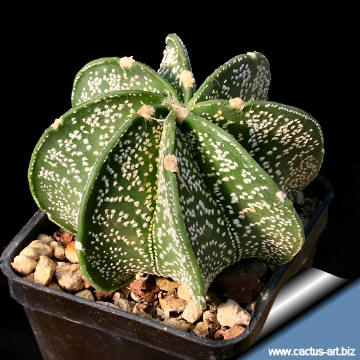|

A young specimen (Ø 4-5 cm) still without
spines.
This is a
juvenile
or
sub-adult feature of this
species, spines appear anyway
later as the plant
ages.
|
Description: Solitary globose or columnar
cactus.
Stem: Although young plants are globular, they
soon become ovoid, and eventually columnar
up to 1.2 m tall, 10 (15) cm in diameter. The
epidermis of is more or less covered with the
typical white woolly flecks characteristic of the genus.
Ribs: Usually 8.
Areoles: In vertical rows along each rib and
Spines: 5 to 10 up to 7 cm long, Grey to brown wired, twisted,
curved, flattened that look like the horn of a Capricorn. As plant ages
spines get a bit more intense and messier, but relatively sparse, they
are stiff but pliable and fragile, so, plant should be handled with
care.
Flowers: Sweet smelling 7.5 cm wide,
yellow with a red center.
Blooming season: Blooms in summer.
Fruit: Reddish covered with flattened spines, 2.5 cm in diameter.
Camouflage: The fine spines of
this species are an optical artifice
supporting the grass-mimicry to the surroundings. |
|
Astrophytum capricorne and its varieties are very
variable in their habit even in small areas.
Plants vary in the amount of flock on the surface,
in the number, length,
shape and colour of the twisted spines,
and in the size of the stems.
And it is understandable that today we often have problems to decide to
which population plants belong.
|